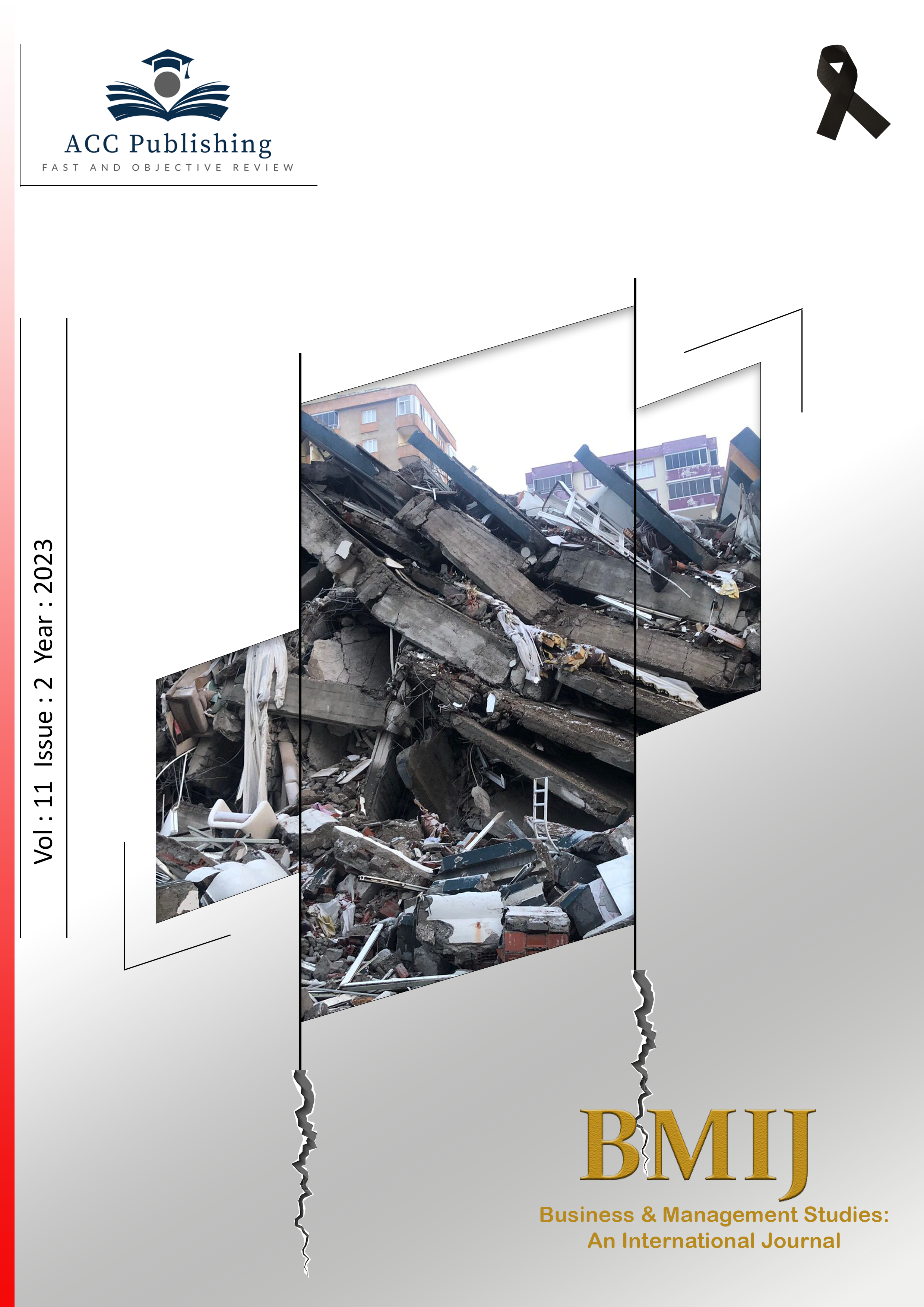
Yayınlanmış 26.06.2023
Anahtar Kelimeler
- İş Biçimlendirme, İşe Adanmışlık, Kişi-İş Uyumu
- Job Crafting, Work Engagement, Person-Job Fit
Nasıl Atıf Yapılır
Telif Hakkı (c) 2023 İlkay Güleryüz- Lütfi Sürücü

Bu çalışma Creative Commons Attribution-NonCommercial-NoDerivatives 4.0 International License ile lisanslanmıştır.
Nasıl Atıf Yapılır
Öz
İşletmelerin ve akademik dünyanın odak noktalarından olan örgütsel davranış konusunda sürekli yenilik ve değişimler görülmektedir. İş biçimlendirme, işe adanmışlık ve kişi-iş uyumu da bu değişimlerin başında gelmektedir. Özellikle bu değişkenler arasındaki ilişkilerin belirlenmesi hem literatür hem de işletme dünyası açısından önem taşımaktadır. Bu çalışmada iş biçimlendirme ve işe adanmışlık arasındaki ilişkide kişi-iş uyumunun düzenleyici rolü incelenmiştir. Türkiye’de araştırmalarına devam eden 308 akademisyene internet üzerinden anket uygulanarak veriler toplanmıştır. Toplanan bu veriler AMOS-22 ve SPSS-27 paket programları kullanılarak analiz edilmiştir. Değişkenler arasındaki ilişkiyi tespit için korelasyon analizi ve hipotezleri test etmek için Process Macro ile regresyon analizi yapılmıştır. Analizler sonucunda iş biçimlendirmenin işe adanmışlığı artırdığı ve kişi-iş uyumunun iş biçimlendirme ve işe adanmışlık ilişkisinde düzenleyici rolü olduğu tespit edilmiştir.
Referanslar
- Anderson, J. C. ve Gerbing, D. W. (1988). Structural equation modeling in practice: a review and recommended two-step approach, Psychological Bulletin, 103(3), 411–423.
- Bakker, A. (2008). Building engagement in the workplace, In The peak performing organization (pp. 96-118). Routledge.
- Bakker, A. B. (2011). An Evidence-Based Model of Work Engagement, Current Directions in Psychological Science, 20(4), 265–269.
- Bakker, A. B., Tims, M. ve Derks, D. (2012). Proactive personality and job performance: The role of job crafting and work engagement, Human relations, 65(10), 1359-1378.
- Bakker, A.B., ve Demerouti, E. (2007). The Job Demands-Resources model: State of the art, Journal of Managerial Psychology, 22, 309-328.
- Bindl, U. K., ve Parker, S. K. (2011). Proactive work behaviour: Forward-thinking and change-oriented action in organizations. In APA handbook of industrial and organizational psychology, Vol 2: Selecting and developing members for the organization. (pp. 567-598). American Psychological Association.
- Blessing White (2008). The Employee Engagement Equation in India. Presented by Blessing White and HR Anexi, [Online] www.blessingwhite.com (Erişim Tarihi: 17.03.2023)
- Cable, D. M. ve DeRue, D. S. (2002). The convergent and discriminant validity of subjective fit perceptions, Journal of applied psychology, 87(5), 875.
- Chang, H. T., Hsu, H. M., Liou, J. W., ve Tsai, C. T. (2013). Psychological contracts and innovative behavior: a moderated path analysis of work engagement and job resources. Journal of Applied Social Psychology, 43(10), 2120-2135.
- Chen, C. Y., Yen, C. H. ve Tsai, F. C. (2014). Job crafting and job engagement: The mediating role of person-job fit, International Journal of Hospitality Management, 37, 21-28.
- Chen, L., ve Lin, C. (2023). Does Person-Job Fit Mediate the Relationship Between Public Service Motivation and Work Engagement? The Case of Chinese Civil Servants. In Frontier Research in Behavioural Public Administration (pp. 89-101). Singapore: Springer Nature Singapore.
- Crawford, E.R., LePine, J.A. ve Rich, B.L. (2010). Linking job demands and resources to employee engagement and burnout: A theoretical extension and meta-analytic test, Journal of Applied Psychology, 95, 834–848.
- Çetin, F., Güner, G. ve Basım, N. (2021). İş biçimlendirme (job crafting) ölçeği’nin Türkçe’ye uyarlanması, İş ve İnsan Dergisi, 8(2), 257-271.
- Dawson, J. F. (2014). Moderation in management research: What, why, when, and how, Journal of business and psychology, 29(1), 1-19.
- Demerouti, E., Bakker, A. B. ve Gevers, J. M. (2015). Job crafting and extra-role behaviour: The role of work engagement and flourishing, Journal of Vocational Behaviour, 91, 87-96.
- Fornell, C. ve Larcker, D. F. (1981). Evaluating structural equation models with unobservable variables and measurement error, Journal of Marketing Research, 18(1), 39-50.
- Guo, Y. ve Hou, X. (2022). The effects of job crafting on tour leaders’ work engagement: the mediating role of person-job fit and meaningfulness of work, International Journal of Contemporary Hospitality Management.
- Hair, J. F., Hult, G. Tomas M., Ringle, C. M. ve Sarstedt M. (2017). A primer on partial least squares structural equation modeling (PLS-SEM), SAGE Publications, Printed in The United States of America, Second Edition.
- Hair, J. F., Risher, J. J., Sarstedt, M. ve Ringle, C. M. (2019). When to use and how to report the results of PLS-SEM, European Business Review, 31(1), 2-24.
- Hakanen, J. J., Bakker, A. B. ve Demerouti, E. (2005). How dentists cope with their job demands and stay engaged: The moderating role of job resources, European journal of oral sciences, 113(6), 479-487.
- Harju, L. K., Hakanen, J. J. ve Schaufeli, W. B. (2016). Can job crafting reduce job boredom and increase work engagement? A three-year cross-lagged panel study, Journal of Vocational Behaviour, 95–96(August-October), 11–20
- Khawaja, A., Ahmad, M. B., Ramzan, M. ve Durrani, M. K. (2023). Role of Job Crafting & Work Engagement: Application of Person Job (PJ) Fit, Journal of Policy Research, 9(1), 20-27.
- Kılınç, N. ve Karaçay, H. (2021). İşgücü Piyasasında Kadının Konumu ve Cinsiyete Dayalı Ayrımcılık: Neoklasik ve Marksist Yaklaşımlar Üzerine Bir Değerlendirme. Journal of International Management Educational and Economics Perspectives, 9(1), 24-33.
- Kim, H. ve Tak, J. (2015). The effect of leader empowering behaviour on work engagement: The mediating role of job crafting and moderating effects of core-self evaluation and person-job fit, Korean Journal of Industrial and Organizational Psychology, 28(2), 275-299.
- Kristof‐Brown, A. L., Zimmerman, R. D. ve Johnson, E. C. (2005). Consequences OF INDIVIDUALS'FIT at work: A meta‐analysis OF person–job, person–organization, person–group, and person–supervisor fit, Personnel psychology, 58(2), 281-342.
- Leana, C., Appelbaum, E. ve Shevchuk, I. (2009). Work process and quality of care in early childhood education: The role of job crafting, Academy of management Journal, 52(6), 1169-1192.
- Lu, C. Q., Wang, H. J., Lu, J. J., Du, D. Y. ve Bakker, A. B. (2014). Does work engagement increase person–job fit? The role of job crafting and job insecurity, Journal of vocational behaviour, 84(2), 142-152.
- Lyons, P. (2008). The crafting of jobs and individual differences, Journal of Business and Psychology, 23, 25-36.
- Mäkikangas, A. (2018). Job crafting profiles and work engagement: A person-centered approach, Journal of Vocational Behaviour, 106, 101-111.
- Martin, J. (2020). Workplace engagement of librarians and library staff, Journal of Library Administration, 60(1), 22–40.
- McClelland, M. M., Cameron, C. E., Duncan, R., Bowles, R. P., Acock, A. C., Miao, A. ve Pratt, M. E. (2014). Predictors of early growth in academic achievement: The head-toes-knees-shoulders task, Frontiers in psychology, 5, 599.
- Netemeyer, R. G., Boles, J. S., Mckee, D. O. ve Mcmurrian, R. (1997). An invesitgation into the antecedents of organizational citizenhip behaviours in a personal selling context, Journal of Marketing, 61(3), 8598
- Nielsen, K. ve Abildgaard, J. S. (2012). The development and validation of a job crafting measure for use with blue-collar workers, Work & Stress, 26(4), 365-384.
- Nykolaiszyn, J. M. (2023). The impact of job crafting and work engagement on academic librarians before and during the COVID-19 pandemic, The Journal of Academic Librarianship, 102697.
- Özkalp, E. ve Meydan, B. (2015). Schaufeli ve Bakker tarafindan geliştirilmiş olan İşe Angaje Olma ölçeğinin Türkçe’de güvenilirlik ve geçerliliğinin analizi, ISGUC The Journal of Industrial Relations and Human Resources, 17(3), 1-19.
- Parker, S. K. ve Griffin, M. A. (2011). Understanding active psychological states: Embedding engagement in a wider nomological net and closer attention to performance, European Journal of work and organizational psychology, 20(1), 60-67.
- Petrou, P., Demerouti, E., Peeters, M. C., Schaufeli, W. B. ve Hetland, J. (2012). Crafting a job on a daily basis: Contextual correlates and the link to work engagement, Journal of Organizational Behaviour, 33(8), 1120-1141.
- Podsakoff, N. P., Le Pine, J. A. ve Le Pine, M. A. (2007). Differential challenge stressor–hindrance stressor relationships with job attitudes, turnover intentions, turnover, and withdrawal behaviour: A meta-analysis, Journal of Applied Psychology, 92, 438–454.
- Rayan, A. R., Sebaie, A. S., ve Ahmed, N. A. (2019). Empowering Leadership Behaviour and Work Engagement: The Mediating Role of Psychological Empowerment. Current Perspective to Economics and Management, 3(12), 27-43.
- Schaufeli, W. B., Bakker, A. B. ve Salanova, M. (2006). The measurement of work engagement with a short questionnaire a cross-national study, Educational and Psychological Measurement, 66(4), 701-716.
- Schaufeli, W. B., Bakker, A. B. ve Van Rhenen, W. (2009). How changes in job demands and resources predict burnout, work engagement, and sickness absenteeism, Journal of Organizational Behaviour: The International Journal of Industrial, Occupational and Organizational Psychology and Behaviour, 30(7), 893-917.
- Schaufeli, W. B., Salanova, M., González-Romá, V. ve Bakker, A. B. (2002). The measurement of engagement and burnout: A two sample confirmatory factor analytic approach, Journal of Happiness studies,3, 71-92.
- Sürücü, L. ve Maslakçı, A. (2020). Validity and reliability in quantitative research, Business & Management Studies: An International Journal, 8(3), 2694-2726.
- Sürücü, L., Şeşen, H. ve Maslakçı, A. (2023). Regression, Mediation/Moderation, and Structural Equation Modeling with SPSS, AMOS, and PROCESS Macro. Livre de Lyon, France
- Thai, K. P., To, A. T., Tran, T. S., Hoang, V. T. ve Ho, T. T. H. (2023). How Job Crafting Transmits the Impact of Perceived Organizational Support and Autonomy on Work Engagement.
- Tims, M. ve Bakker, A. B. (2010). Job crafting: Towards a new model of individual job redesign, SA Journal of Industrial Psychology, 36(2), 1-9.
- Tims, M., Bakker, A. B. ve Derks, D. (2012). Development and validation of the job crafting scale. Journal of Vocational Behaviour, 80(1), 173–186.
- Topa, G. ve Aranda-Carmena, M. (2022). It Is Better for Younger Workers: The Gain Cycle between Job Crafting and Work Engagement, International Journal of Environmental Research and Public Health, 19(21), 14378.
- Turunç, Ö. ve Çelik, M. (2012). İş tatmini-kişi-örgüt uyumu ve amire güven kişi-örgüt uyumu ilişkisinde dağıtım adaletinin düzenleyici rolü, İş, Güç Endüstri İlişkileri ve İnsan Kaynakları Dergisi, 14(2).57-78.
- Varoğlu, K., Basım, N., Sözen, H. C., Yeloğlu, O., Sağsan, M., ve Şeşen, H. (2014). Örgütsel değişim ve öğrenme. İstanbul: Beta Yayıncılık.
- Wrzesniewski, A. ve Dutton, J. E. (2001). Crafting a job: Revisioning employees as active crafters of their work, Academy of management review, 26(2), 179-201.
- Zhang, F. ve Parker, S. K. (2019). Reorienting job crafting research: A hierarchical structure of job crafting concepts and integrative review, Journal of organizational behaviour, 40(2), 126-146.



